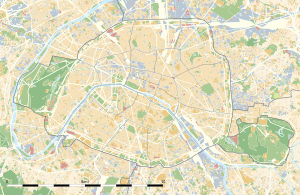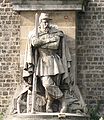Pont de l'Alma
Coordinates: 48 ° 51 ′ 49 ″ N , 2 ° 18 ′ 6 ″ E
| Pont de l'Alma | ||
|---|---|---|
| use | Road bridge | |
| Crossing of | His | |
| place | Paris | |
| construction | Box girder bridge | |
| overall length | 142.5 m | |
| width | 42 m | |
| Number of openings | two | |
| Longest span | 110 m | |
| start of building | 1854/1970 | |
| completion | 1856/1974 | |
| location | ||
|
|
||
The Pont de l'Alma is a road bridge in Paris over the Seine . It is one of the connections between the 7th and the 8th or 16th arrondissement .
Avenue Georges V, descending from the Champs-Elysées, is located in the northern extension of the bridge axis. Avenue Marceau runs towards it from Place Charles-de-Gaulle (Étoile) at an acute angle .
The next bridge upstream is the Pont des Invalides , downstream the Passerelle Debilly and after it the Pont d'Iéna between the Eiffel Tower and the Palais de Chaillot with the Jardins du Trocadéro .
Steel Bridge (1976)
The Pont de l'Alma is 142.5 m long and 42 m wide. It has two 14 m wide lanes, sufficient for four lanes each and a cycle path delimited by markings, as well as a 6 m wide sidewalk on both sides. The central axis is marked by a 2 m wide, raised strip on which, as well as on the sidewalks, there are lighting poles.
From a technical point of view, these are two parallel steel bridges, which are only connected to one another by the raised central reservation and are supported by a shared pillar structure. They each consist of two hollow boxes , the height of which decreases from the pillar to the banks, and an orthotropic plate as a bridge deck.
The pillar structure is close to the north, right bank of the Seine; the two bridges therefore have spans of only 31.5 m above the bank area of the Port de la Conference and its moorings, but 110 m above the fairway and the Voie Express Rive Gauche . Because of the poor soil conditions, the foundation of the pillar structure extends down to 40 m below the surface of the water. The abutments are also based on reinforced concrete piles. The old Zuave of the Pont de l'Alma was re-erected in front of the pillar (a stone figure over 5 m high after Napoleon III's troops in the Crimean War from 1853 to 1856). The Zouave figure was considered an unofficial high water mark by the population. When the water of the Seine reached her feet, the bank paths were closed if it was up to her hips ...
The bridge was built between 1974 and 1976 according to the plans of the engineers Jean François Coste and Ch. Blanc, who were advised by the architects A. Arsac and M. Dougnac.
Stone Arch Bridge (1856) and Passerelle (1900)
The first bridge was built at the instigation of Emperor Napoleon III. executed after victory in the Battle of Alma on September 20, 1854, the first battle of the Crimean War . It was a brick arch bridge with three elliptical arches of 38.5 m + 43.0 m + 38.5 m width and two 5 m thick river pillars . It was supposed to be ready for the opening of the World's Fair on May 1st, 1855, but high tides delayed completion until April 2nd, 1856. In front of the pillars were 4 statues of soldiers from the troops involved in the battle.
For the World Exhibition in 1900 , the bridge was enlarged by doubling the bridge on the mountain side, the Passerelle de l'Alma .
Significant subsidence soon became apparent, which became so severe over the decades that a new building was inevitable in the 1960s.
Statues of the 4 soldiers
Chasseur à pied by Auguste Arnaud, on the Bois de Vincennes
Artilleur from Auguste Arnaud, in La Fère
Of the four statues of soldiers erected on the pillars of the original bridge, only the Zuave by Georges Diebolt found a place in front of the pillar of the new Pont de l'Alma.
- The Grenadier by Georges Diebolt is now in Dijon , the birthplace of Diebolt at the 1964 inaugurated artificial Kir Lake. ( ⊙ )
- The Chasseur à pied ( Hunter ) by Auguste Arnaud is now on an outside wall of the Redoute de Gravelle at the Bois de Vincennes in the east of Paris, where he traffic on the A4 autoroute has (autoroute de l'Est) in view. ( ⊙ )
- The artilleur (gunner) by Auguste Arnaud is in La Fere , Aisne region Hauts-de-France , a former garrison town, in the 41st Marine Artillery Regiment was stationed. ( ⊙ )
At the bridge
Flame de la Liberté
Under the Place de l'Alma at the northern end of the bridge, a four-lane underpass, usually called the Tunnel de l'Alma , runs about 140 m long, with which part of the traffic on the avenue de New York and Cours Albert Ier under the square is passed through. The tunnel ceiling is supported by concrete supports between the two directional lanes.
Above the western end of the tunnel stands the Flamme de la Liberté (Flame of Freedom), a natural-size replica of the flame of the Statue of Liberty made of gilded copper , about 3.5 m tall, on a base made of gray and black marble. It was given to the city of Paris in 1987 by the then International Herald Tribune and various donors as thanks for the restoration work on the Statue of Liberty by two French companies and also as a memorial to the centenary of the International Herald Tribune.
After Diana, Princess of Wales , her friend Dodi Al-Fayed and their driver Henri Paul died in the tunnel on the night of August 30, 1997, the Flamme de la Liberté became the unofficial Lady Di memorial.
Musée des Égouts de Paris
On the other, left side of the Seine, immediately above the abutment of the bridge, is the entrance to the underground Musée des Égouts de Paris , a museum about the development of the Paris sewers.
Web links
Individual evidence
- ↑ a b c Pont de l'Alma on Planete-TP.com
- ↑ Bridges of Paris on LCPC, now Ifsttar
- ^ A b Marcel Prade: Ponts & Viaducs au XIXe Siècle . Brissaud, Poitiers 1988, ISBN 2-902170-59-9 , p. 319
- ↑ a b Flamme de la Liberté - Stèle commémorative à la Princesse Diana on ParisInfo.com
- ^ Paris Honors Diana with Two Memorials. On People.com
- ↑ Musée des Égouts de Paris. on ParisInfo.com








